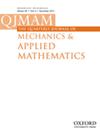粘滞流体中球形粒子沿滑动壁的运动
IF 0.8
4区 工程技术
Q3 MATHEMATICS, APPLIED
Quarterly Journal of Mechanics and Applied Mathematics
Pub Date : 2015-05-01
DOI:10.1093/QJMAM/HBV001
引用次数: 12
摘要
在Stokes方程的框架下,计算了固体球形颗粒在粘性流体流动中的运动,其中壁面采用了Navier滑移条件,颗粒采用了无滑移条件。从斯托克斯方程的线性性出发,解决了纯剪切流中绕球体平移和旋转的问题,作为基本问题的总和:一个球体固定在靠近壁面的剪切流中,一个球体在静止流体中沿壁面平移和旋转。采用双球坐标法,以流体速度和压力为级数,对蠕变流量进行了解析计算。未知的耦合系数无穷级数通过7到4的组合来减少。与先前关于平移和旋转问题的工作相比,这简化了公式。然后使用扩展的Thomas算法求解系数的无限线性系统,该算法允许计算级数中的O(105)项。如此高的数值对于在小球体与壁面间隙(小至10−5球体半径)下获得良好的精度是必要的,特别是对于壁面上的大滑移。然后对三个基本问题中的每一个都得到了作用在粒子上的力和扭矩的精确结果。在此基础上,给出了平行于滑动壁面的自由旋转球体稀悬液的扩散系数,以及沿滑动壁面的纯剪切流中自由运动球体的平移速度和旋转速度。简化的公式提供了应用于各种物理问题,例如,通过跟踪靠近疏水壁的粒子来解释微观尺度上的速度测量。本文章由计算机程序翻译,如有差异,请以英文原文为准。
Motion of a spherical particle in a viscous fluid along a slip wall
Summary The motion of a solid spherical particle in the flow of a viscous fluid is calculated in the framework of Stokes equations, when the Navier condition of slippage applies on the wall and the no-slip condition applies on the particle. The problem for the flow around a sphere translating and rotating in a pure shear flow is solved, from the linearity of Stokes equations, as the sum of elementary problems: a sphere held fixed in a shear flow close to a wall, a sphere translating and rotating along a wall in a fluid at rest. The creeping flow is calculated analytically using the bispherical coordinates technique that provides the fluid velocity and pressure as series. The unknown coupled infinite series of coefficients are reduced by combinations from seven to four. This simplifies the formulation compared with earlier works on the translation and rotation problems. The infinite linear system for the coefficients is then solved using an extension of Thomas algorithm that allows to calculate O(10 5 ) terms in the series. Such a high number is necessary to obtain a good accuracy at small sphere to wall gaps down to 10 −5 sphere radius, in particular for a large slip on the wall. Accurate results for the force and torque on the particle are then obtained for each of the three elementary problems. On this basis, results are provided for the diffusion coefficient of a dilute suspension of freely rotating spheres parallel to a slipping wall and for the translational and rotational velocities of a freely moving sphere in a pure shear flow along such a wall. Simplified formulae are provided for application to various physical problems, like for instance the interpretation of velocity measurements at micro-scales by tracking of particles close to a hydrophobic wall.
求助全文
通过发布文献求助,成功后即可免费获取论文全文。
去求助
来源期刊
CiteScore
1.90
自引率
11.10%
发文量
14
审稿时长
>12 weeks
期刊介绍:
The Quarterly Journal of Mechanics and Applied Mathematics publishes original research articles on the application of mathematics to the field of mechanics interpreted in its widest sense. In addition to traditional areas, such as fluid and solid mechanics, the editors welcome submissions relating to any modern and emerging areas of applied mathematics.

 求助内容:
求助内容: 应助结果提醒方式:
应助结果提醒方式:


